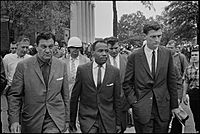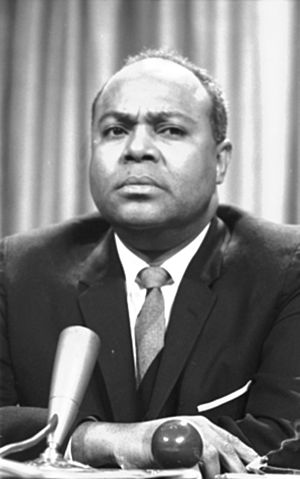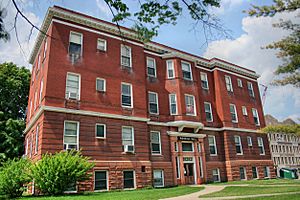Richard E. Holmes facts for kids
Richard E. Holmes, born in 1944, is an American doctor. He specialized in emergency medicine. In 1965, he made history by enrolling at Mississippi State University (MSU). This university had only allowed white students before. Richard Holmes was one of the first Black students to attend a major state university in Mississippi. This was an important part of the Civil Rights Movement. His enrollment at MSU was very peaceful, especially compared to earlier attempts by others.
After graduating from MSU, Holmes served in the US Army. He then earned a master's degree and later became a medical doctor. He worked as an emergency room doctor in hospitals in Birmingham, Alabama. In 2003, he returned to MSU. He became a doctor at the university's health center. Richard Holmes has been honored many times for his brave actions and his contributions.
Contents
Richard Holmes's Early Life and School
Richard E. Holmes was born in Chicago, Illinois, on February 17, 1944. His parents were Horace and Minnie Holmes. He had three older brothers. When Richard was about 18 months old, his mother took him and his brothers to Mississippi. They settled in Starkville, Mississippi. They lived with Eliza Hunter, a family friend whom Holmes thought of as his "grandmother." Mrs. Hunter taught the boys important lessons. She taught them about education, hard work, honesty, and religion. She told them that "being poor and black was no reason for failure."
Mrs. Hunter passed away in 1956 when she was 86. Before she died, she made sure Holmes, who was 12, had a place to live. He went to live with Dr. Douglas Conner and his wife. Dr. Conner was a local doctor in Starkville. He was also a leader in the African-American community and worked for civil rights. Dr. Conner became Holmes's godfather and a very important mentor. He encouraged Richard to stay in school and study hard.
In 1963, Holmes graduated from Henderson High School in Starkville. This school was only for Black students at the time. Dr. Conner then sent him to Wiley College. Holmes studied pre-med courses there for two years. Wiley College is a private, historically black college in Marshall, Texas. Many students and teachers at Wiley were active in the civil rights movement.
Important civil rights leaders like James L. Farmer, Sr. and his son James Farmer had connections to Wiley College. James Farmer was the director of CORE when Holmes was at Wiley. These mentors taught Holmes about working slowly but steadily for civil rights. They also taught him about bringing different races together.
Joining the Civil Rights Movement
Holmes might have wondered why he was studying in Texas when MSU was in his hometown. He was likely worried about his safety. Other Black students had faced violence when trying to attend Mississippi universities. For example, Clyde Kennard was wrongly put in prison. James Meredith faced dangerous riots.

In 1960, Clyde Kennard was sent to prison on false charges. This happened when he tried to attend the University of Southern Mississippi. White people who supported segregation caused riots at the University of Mississippi in 1963. This was after a court ordered that James Meredith be allowed to attend. The governor at the time, Ross Barnett, refused to let Meredith in. President John F. Kennedy had to send National Guard troops to stop the riots. They also protected James Meredith.
It is not fully clear how Richard Holmes became the first Black student at Mississippi State. His decision likely came from many places. It could have been his own idea, or from his mentor Dr. Conner. The local NAACP chapter, MSU President Dr. Dean W. Colvard, and his friends at Wiley College might have also played a role. The NAACP had supported similar efforts before. Two months later, they helped Raylawni Branch and Gwendolyn Elaine Armstrong enroll at the University of Southern Mississippi.
By 1965, people in Mississippi's higher education system started working towards integration. This included both those who wanted change and those who supported segregation. President Colvard's leadership at MSU was considered moderate for that time. In 1963, Dr. Colvard bravely sent his champion basketball team to the integrated NCAA championships. He went against the wishes of white state politicians who wanted to keep them out because of race. In 1965, Colvard, his staff, and the teachers wanted to find a peaceful way to integrate the university.
Holmes's Peaceful Enrollment at MSU
Holmes enrolled for the summer semester in July 1965. This was when the fewest people would be on campus. He told the admissions office that he would only stay for the summer. He said he would return to Wiley College in the fall. He was always quiet and polite. He worked to avoid any possible problems. He still says, "I didn't set out to be an integrationist."
Holmes later described his first day: "There were no catcalls, no racial slurs... It was quiet and serene. Nothing happened; there was just curiosity and disbelief." He noticed that white students would not sit at the same table as him in the library or cafeteria. This made him feel isolated. He sometimes heard people heckle him, but he said it did not feel personal. He said, "Some befriended me and treated me with dignity and respect. Many just ignored me."
After a successful summer semester with few problems, the Colvard administration encouraged Holmes to return for the fall. He did. Dr. Conner and other Black community members also asked Holmes to stay. They said his presence was very important for any other Black student thinking about enrolling. Dr. Dean W. Colvard and the teachers supported him. Overall, the students at MSU treated Holmes well.
The university arranged for Holmes to have a room in the new Evans Hall. This dorm was usually for graduate students. His biggest challenge was feeling alone because white students kept their distance. Most of his friends from Starkville were at other colleges. MSU students were hesitant to be openly friendly with him. This was because of the strong social rules in Mississippi at the time. He missed the activities he had enjoyed at Wiley. There, he had been active in the Kappa Alpha Psi fraternity and the football team. He sometimes wished he could have continued those activities.
Many students probably did not realize how important this moment was. In the fall, a Mexican-American student from Tucson, Arizona, came to the campus Baptist Student Union for Thanksgiving. She told the minister she had seen another Mexican student on campus. She described Holmes and thought she might invite him to the BSU. The minister replied, "Oh no! That's the Negro student who's integrating us. But, I think he's Methodist."
For the next two years, Holmes worked hard to earn a bachelor's degree in liberal arts. He needed money, so in 1967, he left full-time student status. He taught school nearby in Alabama. He continued his studies part-time with night and correspondence courses. He graduated with a B.A. in 1969.
Holmes joined the US Army and served for two years. After that, he completed a master's degree in microbiology and nutrition in 1973. This was a pre-med program. He then went to medical school at Michigan State University. He finished his M.D. in 1977. After medical school, he did several internships in Alabama and his residency in Ohio.
Richard Holmes's Family Life
Richard Holmes and his wife, Judie Granderson, have two children. Judie was a school teacher from nearby Columbus, Mississippi. Their children are a daughter named Rikeda and a son named Richard Holmes, Jr.
Richard Holmes's Career as a Doctor
Holmes became a specialist in emergency medicine. He settled in Birmingham, Alabama. He worked as an emergency department doctor in hospitals there for 23 years. During this time, he stayed loyal to and interested in his old university, MSU.
Later Years and Return to MSU
In 2003, Dr. Robert Collins asked Holmes to return to Mississippi State University. Holmes became a staff physician at the John C. Longest Student Health Center.
Holmes, with his gray hair and quiet manner, quickly became a favorite member of the Mississippi State community. The university president, Charles Lee, said:
The university gained from the courage and dignity (Dr. Holmes) demonstrated in 1965,... Today's students are benefiting and learning from the professionalism and compassion that are evident in his practice as a campus physician.... He has been, and remains, an inspiration, a role model and a mentor.
Richard Holmes's Legacy and Honors
- In 1991, Mississippi State honored Holmes by naming the university's cultural diversity center after him.
- Holmes has given his personal and work papers to the MSU Mitchell Memorial Library.
- He and his wife Judie started a scholarship fund in his name. This scholarship helps minority students.
- In 2003, Holmes was invited to give the spring graduation speech at Mississippi State University.
- In 2005, he was chosen to be a member of the Wiley College Board of Trustees.
- In 2006, he was named Mississippi State's National Alumnus of the Year. This is a top honor for a former student.
- In 2007, the Mississippi State Legislature officially recognized and praised Holmes for his career and his work at Mississippi State.



